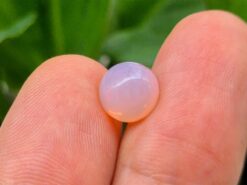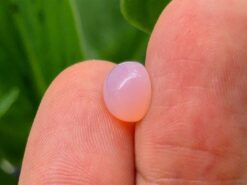Lazulite

Lazulite ((Mg,Fe2+)Al2(PO4)2(OH)2) is a blue, phosphate mineral containing magnesium, iron, and aluminium phosphate.
Buy natural gemstones in our gem shop
Lazulite meaning
The stone forms one endmember of a solid solution series with the darker iron rich scorzalite.
The gemstone crystallizes in the monoclinic system. Crystal habits include steep bipyramidal or wedge-shaped crystals. It has a Mohs hardness of 5.5 to 6 and a specific gravity of 3.0 to 3.1. It is infusible and insoluble.
High grade metamorphism
It forms by high grade metamorphism of high silica quartz rich rocks and in pegmatites. It occurs in association with quartz, andalusite, rutile, kyanite, corundum, muscovite, pyrophyllite, dumortierite, wagnerite, svanbergite and berlinite in metamorphic terrains; and with albite, quartz, muscovite, tourmaline and beryl in pegmatites. It may be confused with lazurite, lapis lazuli or azurite.
Origin
It is found in Salzburg, Austria; Zermatt, Switzerland; Minas Gerais, Brazil; Lincoln County, Georgia; Inyo County, California; the Yukon in Canada, and elsewhere.
It was first described in 1795 for deposits in Styria, Austria. Its name comes from the German lazurstein, for blue stone or from the Arabic for heaven.
Lazulite gemstone properties
Formula: MgAl2(PO4)2(OH)2
Colour: Blue, sky-blue, bluish white
Luster: Vitreous, Sub-Vitreous, Resinous, Greasy
Hardness: 5½ – 6S
pecific Gravity: 3.122 – 3.24
Crystal System: Monoclinic
Member of: Lazulite Group
Lazulite vs lazurite
The stone takes its name from the German name “Lazustein” or “blue stone”. It is a phosphate mineral with the formula (Mg,Fe)Al2(OH)2(PO4)2. Lazurite is the main mineral in the gemstone lapis lazuli. It is a silicate with a formula of (Na,Ca)8(Al,Si)12O24(s,SO4).
Lapis lazulite
Lapis lazulite does not exist. Ths name is sometimes used by gem traders who are not gemologists and don’t know how to write “lapis lazuli“.
Lazulite crystal properties
It will help you strike a balance between the various chakras in your body. It will also help you maintain your peace of mind. This crystal will increase your powers of focus and concentration. It will infuse you with positive, uplifting spiritual energies.
Sample from Tajikistan
















